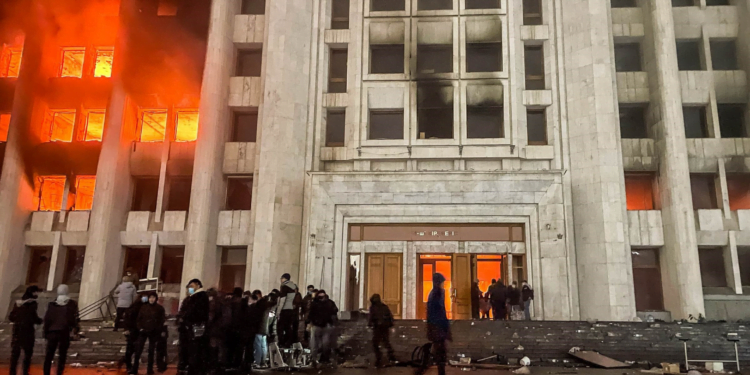Belgium (Brussels Morning Newspaper), In January 2022, Kazakhstan faced its most significant internal crisis since gaining independence 30 years earlier, when the country went through major violent protests.
Initially sparked by demonstrations over rising energy costs, the situation escalated into riots and eventually morphed into what appeared to be a violent attempt to overthrow the government.
Post-investigation findings by Kazakhstan’s law enforcement indicated that organized criminal groups hijacked the initially peaceful protests, to carry out a coup d’état. According to official statements, these groups used the protests to instigate broader disturbances and destabilize the nation. The ultimate goal, according to Kazakh law enforcement, was an attempt to undermine Kazakhstan’s stability and derail its ongoing socio-economic reforms. These reforms faced resistance from an old political elite, who saw these changes as a threat to their long-established power in the country and influence over various lucrative sectors of the economy.
The ongoing inquiry into the January events keeps uncovering fresh proof of criminal activities intended to disrupt stability and undermine the reforms initially launched by Kassym-Jomart Tokayev, the President of Kazakhstan, in 2019. Just a few days ago, the National Security Committee (NSC) of Kazakhstan, the country’s security service reported that another cache containing weapons and ammunition was found in Almaty, the former capital of Kazakhstan, which experienced the largest and most deadly protests in January 2022. NSC stated that 30 units of weaponry were seized, including Kalashnikov rifles, pistols, and shotguns, as well as 5 grenades, 10 smoke bombs, and more than 200 cartridges of various calibers. According to the NSC, the found weapons were stolen during the January events.
It is argued that the discovery of this arsenal once again indicates that the riots in January 2022 were not simply spontaneous uprisings, but rather a coordinated effort by organized armed groups. The fact that weapons such as rifles and grenades were found suggests that those behind the disturbances were planning the attack for some time and were well prepared when the time came. This aligns with the National Security Committee’s ongoing investigations as well as court rulings, which point to an intentional attempt to destabilize the country and upset its political process. The ongoing investigations, including those focusing on the close relatives of the former president, are likely to uncover more details about the organization and motives behind these armed groups, shedding light on the true nature of the January 2022 events in the Central Asian country.
In this regard, media reports have pointed out that this news reflects the narrative that was outlined in a recent documentary titled “January: The Attempted Coup. How It Happened.” As highlighted in the documentary, which was shown at the headquarters of the Council of Europe on January 26, rallies were organized in 11 regions of the country. Simultaneously, in these areas and cities, peaceful protests turned into riots and were later exploited by “conspirators.” The documentary is built around a narrative that incorporates previously unseen footage, eyewitness accounts, and historical documents.
Over the past two years, much has been said about these events and their impact on the country. While Kazakhstan’s law enforcement outlined its version of what took place, some speculation remains. What has been alleged, however, is that high-ranking officials and organized crime members were implicated.
On a wider scale, Kazakh law enforcement took several measures to restore order and hold those responsible accountable. These included extensive investigations, arrests, and trials of individuals involved in the violence. During this time, 5,300 criminal cases have been registered, and almost 1,200 citizens have been convicted (with around 1,000, convicted for mostly minor crimes, and being pardoned later).
The government also accelerated reforms to address the underlying causes of the protests, such as economic issues, and to strengthen the legal and institutional foundations to prevent any possibility of attempts to destabilize the country in the future.
Specifically, President Tokayev, announced in 2022 additional political and socio-economic reforms to transform Kazakhstan’s super-presidential system of government to a presidential republic with a strengthened and more influential Parliament. The reforms aimed to increase public participation in politics and enhance the judicial system. Since then, elections under new rules have been held at all levels, including presidential, parliamentary, and local, to reset the political system in the country and launch what the government terms a ‘Just and Fair Kazakhstan’.
The January 2022 unrest in many ways acted as a catalyst for significant change within the country. It is crucial, therefore, to fully understand what took place two years ago to bring those responsible to justice and ensure that such events never happen again.




